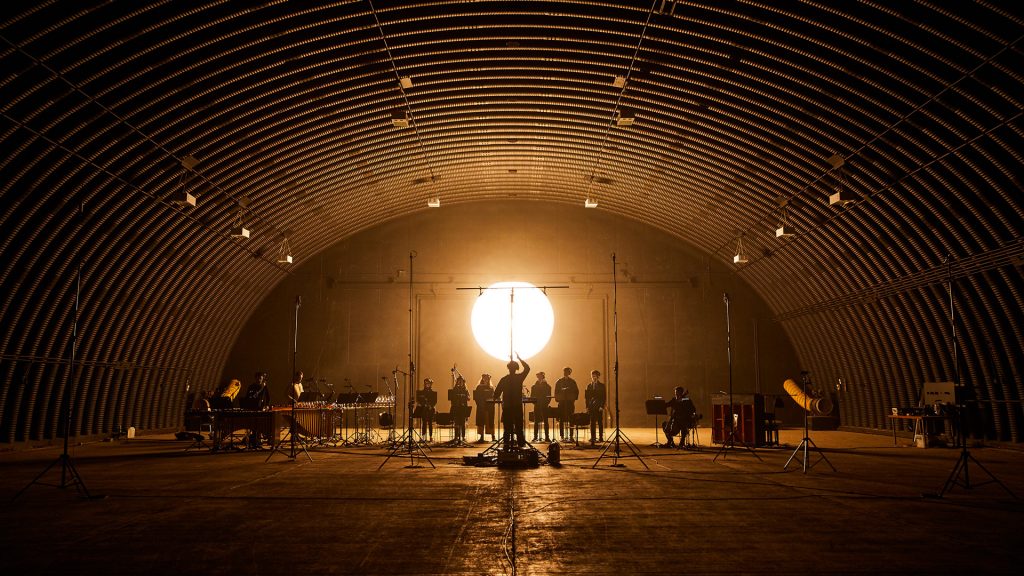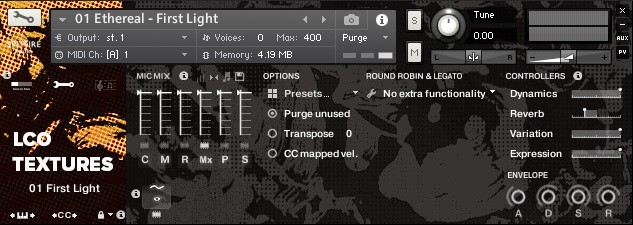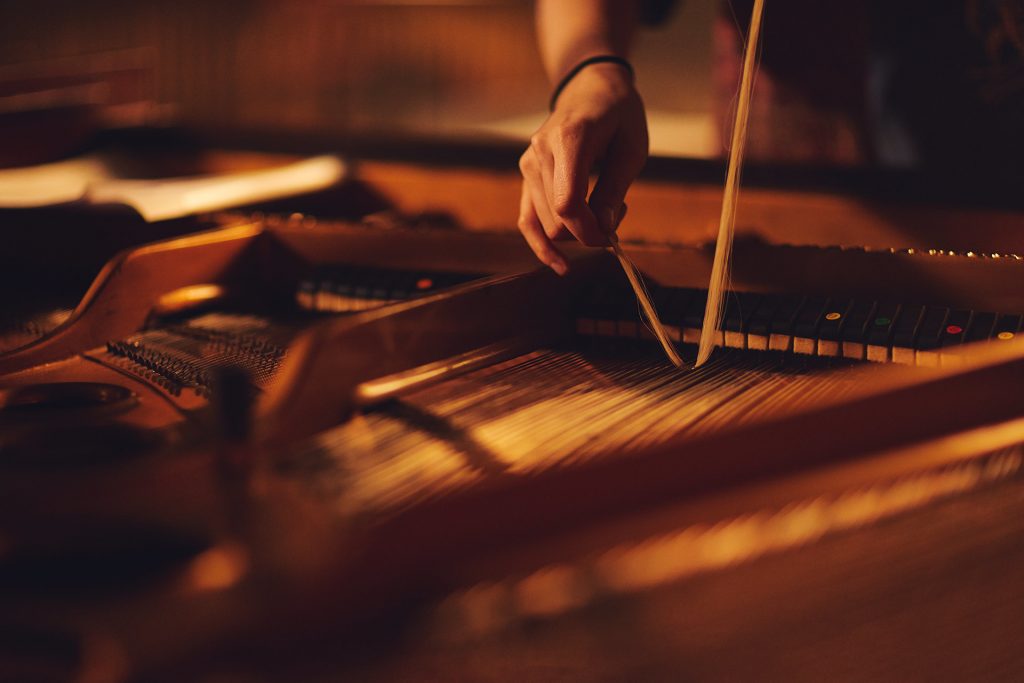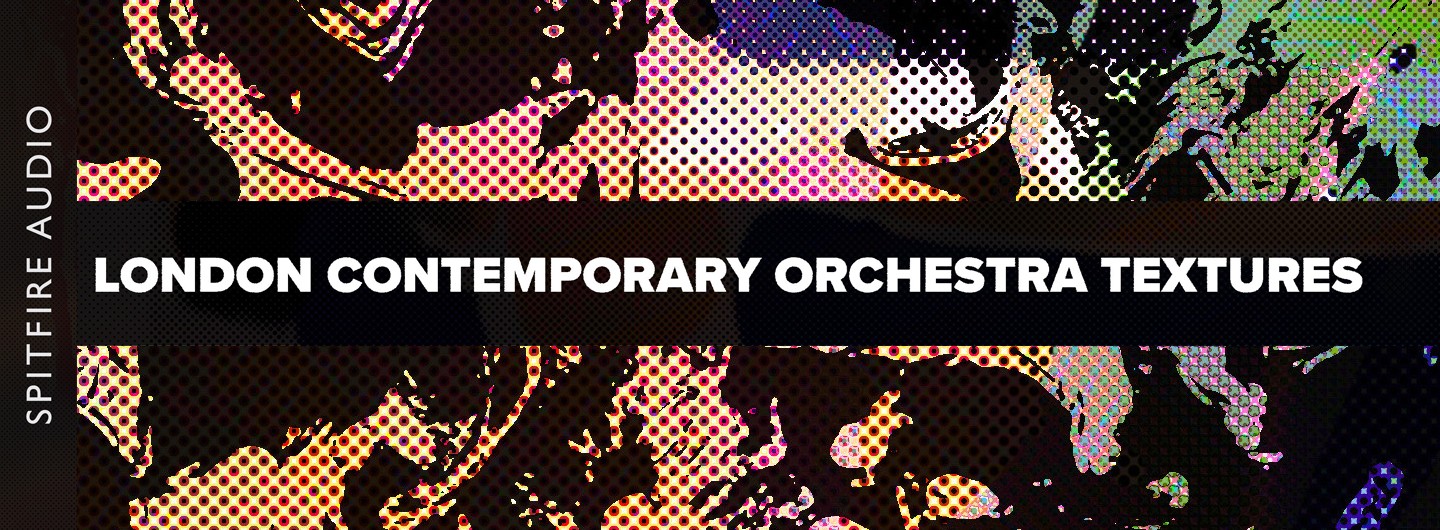London Contemporary Orchestra Textures is Spitfire Audio’s second collaboration with the internationally acclaimed ensemble. By combining the group’s unique performance style and unusual combinations of instruments, they created a never-before sampled sound palette of constantly evolving organic textures.
In search of a truly characteristic acoustic space, the collaborative venture came across a gigantic aircraft hangar with an exceptionally long reverb tail and its own particular resonance. Hosted by Spitfire Audio’s renowned Evo Grid engine, LCO Textures gives access to instantly playable, deep and evolving acoustic sound beds that will add drama and suspense to any score.
In this review, we will be checking out Spitfire Audio’s London Contemporary Orchestra Textures for you and find out together, how the library can enhance your dramatic cues.
OVERVIEW
LCO Textures is a sample library for Native Instruments’ KONTAKT Player (version 5.6.8 or higher) and is fully NKS-compatible. The product is 14.3 GB in size and contains around 3,468 samples. The samples are hosted in Spitfire Audio’s Evo Grid engine, which has already been used for various other products of the brand like Olafur Arnalds’ Chamber Evolutions or the new Evolutions bundle. You get access to 3 main microphone positions (Close, Main Array, Room) together with 2 effects signal paths (stretched & plate reverb) and a full mix – plenty of tonal options to choose from.
LCO Texture features four grouped instrument ensembles, each one comprised of 12 individual textures. Added to that, you get a broad selection of pre-designed, instantly playable presets. All the instrument groups and textures can be combined and mixed to create unique and ever-evolving textural beds.
LONDON CONTEMPORARY ORCHESTRA
(from the Spitfire Audio product site)
The London Contemporary Orchestra, winner of the Ensemble category at the Royal Philharmonic Society Music Awards in 2015, has worked their way into becoming one of the world’s most innovative and acclaimed ensembles by incorporating their unique style into pop music, film & game scores as well as well-attended live performances.
Formed in 2008 by co-Artistic directors and conductors Robert Ames, the LCO is at the top of their game, having collaborated with a wide array of musicians, creative figures and platforms, including Radiohead, Frank Ocean, Jed Kurzel, Steve Reich, Mica Levi, Actress, Arcade Fire, Foals, Nike, Secret Cinema, Boiler Room, NTS, Terry Riley, Hannah Perry and Vivienne Westwood. Highlights include sold-out performances at renowned venues such as Printworks, Tate Modern, Southbank Centre, There Will Be Blood: Live at the Barbican, the critically-acclaimed site-responsive series Imagined Occasions, and live broadcasts on BBC Radio 3. The orchestra has a strong arrangement, recording and performance record for world-class film and television music, having recorded soundtracks such as The Master, Alien: Covenant, Macbeth, Phantom Thread, Assassins’ Creed, You Were Never Really Here, McMafia, Suspiria, American Animals, Moonlight, There Will Be Blood and Under the Skin, and featured heavily on Radiohead’s 2016 A Moon Shaped Pool.

THE TEXTURES
The sounds recorded for the LCO Textures library are presented in four small groups of instruments to keep a sense of intimacy and expression. Each group is comprised of its own, meticulously arranged combination of instruments and players:
ETHEREAL:
- Voices (Sopranos, Mezzo Soprano, Alto, Tenor, Baritone, Bass), Percussion, Cello
MERCURIAL
- Flute (plus Alto & Contra), Harp, Viola, Cellos
QUANTUM:
- Flute (plus Alto & Contra), Piano, Viola, Cellos
ASTRAL:
- Percussion, Felt piano, Cello Harmonics
The instrument groups are designed to be distinct in orchestration, technique and evolutionary style but also to complement each other when layered together. Placing the instruments into an unconventional space (a decommissioned aircraft hangar) allowed the ensembles to play with its unique sound characteristics and long reverb tail. The players experimented with offbeat techniques such as introducing vibrating objects to the instruments, experimenting with quarter-tone variants, adding fifths and extra octaves and introducing a variety of bowed textures.
Sounds that would normally die away quickly were now floating through the hall, exciting unique resonances on their way. The hangar’s distinct sound and its 10-second reverb tail added a vastness and cohesiveness to the instruments that laid the ideal foundation to create shimmery and otherworldly sonic textures.
“Writing for a long reverb is a really fascinating thing to do. Trying to predict how the space is going to feed back into the notes you’ve written for is a really interesting thing… To have an orchestra to play with when curating these sounds — it’s like the ultimate synthesizer.”
Robert Ames, Co-Principal Conductor and Artistic Director of the LCO
Like most of Spitfire Audio’s products, LCO textures was recorded with a variety of microphone positions you can choose from. Apart from the standard Close mics, Main array (combination of Ambient and Outrigger mics) and a Room microphone position, you have access to two more specialized microphone paths. The Plate path allows you to add a distinct plate reverb sound to the already very reverberant samples. The second option, labeled “Stretched”, plays back the samples stretched to two times their original length for ethereal, pad-like effects.
EVO GRID ENGINE
For LCO Textures, Spitfire Audio again deployed their tried and tested Evo Grid engine. Its main element is a 10 x 32 pegboard which gives you access to all texture recordings at the same time across 12 key intervals. Each peg represents an “Evo” or Evolution. Evolutions are long, extensive instrument performances that slowly change and evolve over time until they loop. In the case of LCO Textures, these Evolutions derive from the Hangar recording sessions with the London Contemporary Orchestra using four different instrument ensembles (see Overview). How drastically or smooth the textures evolve depends on the category you choose.

Having all the available textures accessible at any time allows you to either assign different sounds to various key ranges or completely randomize what key triggers which sound. This makes generating interesting and moving soundscapes an absolute breeze and opens the door to literally endless combination possibilities.
Apart from the sound selection panel, the Evo Grid UI also offers some basic manipulation options like panning and leveling for each sound and some global FX. These are based on KONTAKT’s onboard Reverb, Delay and Tape Saturation modules.
In addition to the Evo Grid master patch, Spitfire also included each texture or Evolution on their own as an individual patch. This more traditional method of working with the samples makes it easier to process individual sounds and is more CPU-friendly if you know you just want to use one particular sound.

THE SOUND OF LCO TEXTURES
When I was playing around with the library for the first time, the first impression I got was how good and versatile these evolutions sound across the bank. No matter which combinations I chose or how much I randomized the sound selection, the engine always surprised me with inspiring, interesting and organic sounding textures I never heard before. Each one carries a certain feeling or mood you could use to enhance your musical message. Since the source of these textures is mostly of classical nature, the sounds of LCO Textures blend extremely well with orchestral arrangements. Laying a textural foundation under some strings, brass and woodwinds

Since the Evolutions are always shifting and changing – sometimes slightly, sometimes more drastically – they never feel boring or repetitive. In fact, until today I wasn’t able to discern any loop points or repetitions when holding sounds down for a longer time.
By combining different microphone positions, you can generate beautifully three-dimensional textures that sound intimate and vast at the same time. By combining the Close mics with the time-stretched sound of the Stretched channel, you can create textures with a great sense of clarity upfront that hold a lush and spacious image in the background.
CONCLUSION
LCO Textures is certainly not yet another cinematic pad library. The choice of musicians and instruments, the selection of unusual performance techniques and the characteristic aircraft hangar recording space all led to a collection of extraordinary sounds no other sample library has to offer. These slowly evolving, ever-changing textures created by the London Contemporary Orchestra sound both unearthly and organic at the same time and form instant starting points of dramatic and cinematic cues.
Spitfire’s comprehensive Evo Grid engine feels inspiring to use and offers tons of possible combination options at a mouse click. If you prefer to work with single textures instead, you can load up all the sounds individually, too. The selection of available microphone positions and FX paths offers another source of inspiration, as each one presents LCO’s beautifully crafted textures in its own distinct spotlight.
All in all, London Contemporary Orchestra Textures is a very special sounding and addictive library with a truly extraordinary concept. Its sounds will surely be heard in a lot of upcoming drama scores worldwide.
Spitfire Audio’s London Contemporary Orchestra Textures is available for $299 from the company’s website.


0 comments on “Spitfire Audio – London Contemporary Orchestra Textures (Review)”